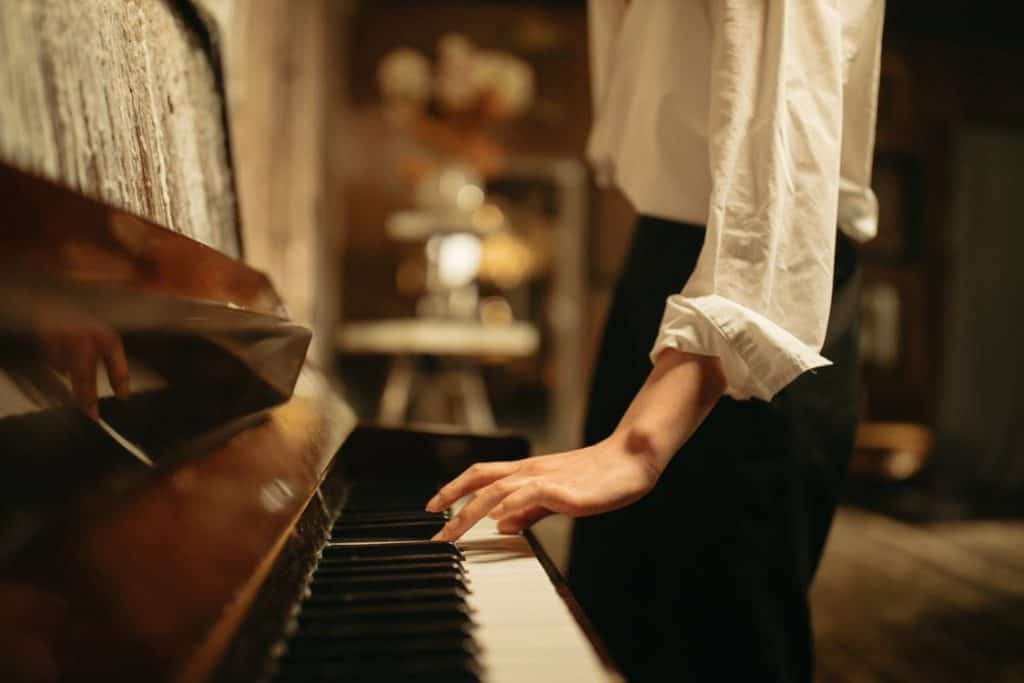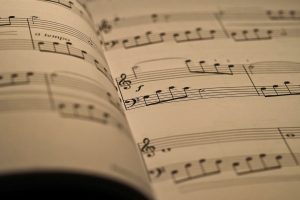Timbre, texture, and tone are three interconnected ideas in music. To the beginning pianist, these ideas may seem nearly identical. It is true that even the most advanced professional musicians will occasionally use these three words interchangeably. However, that is not because they do not know the meaning of them.
In this article, we will explore the meaning of timbre, texture, and tone in music. We will define each concept on its own and explore some of the intricacies and possible contradictions inside of each idea. Then, we will discuss how we can train our ears to use each concept. When you are ready, dive in!

What is the definition of timbre in music?
Timbre is a particular concept in music that refers to the unique characteristics that define the sound quality of an instrument. Timbre is pronounced TAM-ber, not TIM-bre, which is often quite confusing for the beginner. Timbre in music is generally not related to more specific aspects like melody in music, although of course the sound of a melody can be altered based on the timbre of the instrument performing it. What unique characteristics can you think of that define the timbre of the piano as distinct from other instruments like the violin or trumpet?
Harmonic context of timbre
Underneath the surface, the harmonic series is a defining feature of an instrument’s timbre. The harmonic series is a naturally occurring phenomenon that is quite fascinating when you dive into it. Every sound we hear is actually a composite picture of many hidden sounds called harmonics, or overtones. It is a little bit hard to visualize this on the piano simply because we do not often see the inner mechanism of the piano, as opposed to a string instrument where we can visually see the changing positions of our hands on a string.
The harmonic series
In the harmonic series, the most prominent pitch we hear is called the fundamental. The fundamental is the root note of the pitch. So, for example, if you hear the pitch middle C, then C is the fundamental. However, there are many other pitches buried inside of that middle C that you can uncover.
Inside of that single middle C there are actually many of the pitches in our musical system arrayed in a specific pattern. Your mind might be totally blown right now. The order is as follows: the fundamental (C), the octave (C), the fifth (G), the octave again (C), the third (E), the fifth again (G), the flat seventh (B♭), the octave again (C), the second (D), the third again (E), the sharp fourth (F♯), the fifth again (G), the sixth (A), the flat seventh again (B♭), the natural seventh (B), and finally the octave again (C). The last C is actually 4 octaves above the fundamental.
The truth of timbre
This means that for every single key you press on the piano, there are actually 16 different harmonics, or overtones, inside of that pitch. So, essentially timbre in music refers to the sound qualities produced by the balance of these overtones in the harmonic series. Every instrument, even instruments in the same family, will have a different timbre based on their construction and relationship to the harmonic series. This is why no two pianos will ever sound exactly the same.
What is texture in music?
Texture in music is a related concept to timbre. Texture is a word that is sometimes used to describe the aesthetic qualities of a musical sound, much like someone would describe the texture of a food, a piece of cloth, or a painting. Texture in music can also refer to the combination of timbres in music. Musical texture can also include ideas about arrangement and harmony in music. Let’s explore some different types of texture in music.
Monophonic texture in music
A monophonic texture in music occurs when there is a single melody line happening with no accompaniment. Sit down at your piano and play a single melody in your right hand. This is a monophonic texture.
Homophonic textures
Now, play the same simple melody in your right hand, accompanied by the left hand starting the same melody a perfect fifth lower. This is a homophonic texture. A homophonic texture is a multi-voice texture with a single, primary melody line supported by simple harmony lines underneath. The supported textures in homophony is not a separate melodic voice in its own right.
Learn how to play ‘Lean on Me’ by Bill Withers on piano. Start a 7 day trial today – no card details required!
Polyphonic musical texture
A polyphonic texture is the most advanced of the three harmonic textures here. To play a polyphonic texture, continue playing the simple melody in your right hand and begin playing a counter-melody in your left hand. The counter-melody should be distinct enough from the original melody that it could stand on its own.
A polyphonic texture occurs when there are multiple, individual melody lines interacting in concert with one another. Examples of polyphony are myriad, from the work of Bach and Brahms to Radiohead and Nirvana. Anytime two or more distinct melody lines play together, we have polyphony.
Learn how to play ‘Canon in D’ on piano. Start a 7 day trial today – no card details required!
Rhythmic texture
Rhythm can also provide a type of texture. Musicians often use the word texture to describe rhythm in music. A rhythmic texture could be:
- Dense if there are a lot of fast eighth notes happening.
- Sparse if there are a lot of tied whole notes happening.
- Varied if there are fast sections followed by longer, slower sections or if multiple instruments are playing different rhythms at the same time.
For example, how would you describe the rhythmic texture of a piece like “Clocks” by Coldplay?
Learn how to play ‘Clocks’ by Coldplay on piano. Start a 7 day trial today – no card details required!
What is tone in music?
Like texture, tone in music can have many different definitions depending on the situation and context. We can learn how to describe tone in music using a few different tools.
Tone in intervals
The word tone can refer to specific intervals in music. If you are unsure about piano intervals and how to understand them, online piano lessons with Skoove would be a great place to start! With over 400 lessons covering concepts from repertoire to technique to theory, Skoove has everything a beginning pianist needs to succeed!
An interval is the distance between any two notes. We use the “tone” to measure that distance. There is a semitone, which is the distance from one note to the next adjacent note higher or lower. For example, C to B and E to F are both semitones. There is also a whole-tone. A whole-tone is equal to two semitones. For example, C to D, F to G, and A to B are all examples of whole-tones. We use semitones and whole-tones for many purposes in music like building scales, chords, melodies, and understanding music transposition.
Tone and pitch
Sometimes the words tone and pitch are used interchangeably. For example, you might hear a musician refer to middle C as the tone middle C. This distinction might be slightly confusing for some, as tone can refer to both intervals and a quality of sound as we shall see.
Tone as a quality of sound
The third way tone is used in music is more akin to timbre. Tone can refer to specific qualities of sound. For example, dynamic markings in music have an effect on tone. If you play the piano forte in the low end, it produces a darker, heavier, and louder tone than if you play piano in the high end.
However, there is a difference between tone and timbre. Timbre refers to the specific harmonic content of an instrument that differentiates it from other instruments. Tone refers to the sound qualities of a particular sound. For example, many instruments can produce a loud tone or a deep tone or a pleasing tone. However, the specific character, or timbre, of a loud tone or a deep tone or a pleasing tone on a piano is different from the character of those types of tones on a saxophone or a drum set.
How to train your ears for timbre, texture, and tone
Now that we have explored some of the theoretical differences between timbre, texture, and tone, it is necessary to practice some practical applications of these skills. How can we learn to use our ears to differentiate between timbre, texture, and tone? The simple answer is by practicing active listening. Let’s take an example. Listen to this track:
Then try to identify the different elements as they occur. Can you identify the first instrument based on its timbre? What is the texture of the piece at the beginning? Is it monophonic or homophonic? When does the texture become polyphonic? What is the tone of the piece? Is it dark or light? Is it heavier or happier? Are the intervals of the melody wide or small?
Actively listening to music with these concepts in mind is how we can develop the skills to hear elements of timbre, texture, and tone in music. Like all things in the realm of music, it takes time, energy, and dedication to master, but is well worth the journey!
Piecing it all together
Timbre, texture, and tone are three interconnected concepts in sound. They are all important parts of understanding and describing specific events in music and have an important role to play in our development as musicians and in our understanding of music in a larger context. Learning how to hear specific elements of timbre, texture, and tone will expand your abilities as a musician and listener of music in myriads of ways.
Learning piano with Skoove is a great way to practice with timbre, texture, and tone. Skoove’s lessons are rich with examples of various piano timbres, homophonic and polyphonic textures, and tones from joyful and exciting to solemn and introspective. Explore the world of piano with Skoove and enrich your mind and ears together!
Author of this blog post:

Eddie Bond is a multi-instrumentalist performer, composer, and music instructor currently based in Seattle, Washington USA. He has performed extensively in the US, Canada, Argentina, and China, released over 40 albums, and has over a decade experience working with music students of all ages and ability levels.















